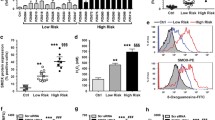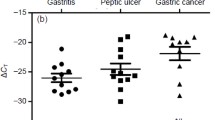Abstract
Helicobacter pylori has been identified in the pathogenesis of chronic active gastritis and peptic ulcer disease and is epidemiologically linked to gastric cancer and lymphoma. Our previous studies have demonstrated enhanced production of reactive oxygen species (ROS) in cultured gastric adenocarcinoma cells (ATCC CRL/1739) in association with H. pylori. Recently, we have isolated and cultured normal human gastric mucosal cells (GMC) from H. pylori-negative endoscopic biopsies. The integrity of these mucosal cells was determined by periodic acid–Schiff staining. We assessed the effects of various H. pylori strains including 60190 (a 87-kDa cytotoxin producing strain), ATCC 43504, and 60190-v1 (in which the cytotoxin gene has been disrupted) on the primary culture of human gastric mucosal cells. The induction of ROS and DNA fragmentation in the mucosal cells in association with these H. pylori strains were assessed by cytochrome c reduction (an index of superoxide anion production), hydroxyl radical production, and DNA fragmentation. Following incubation of the mucosal cells with 1:0.5 and 1:1 ratios of H. pylori strain 60190, approximately 6.2- and 9.9-fold increases were observed in cytochrome c reduction, respectively, as compared to mucosal cells in the absence of H. pylori, demonstrating the production of superoxide anion. The detection of hydroxyl radicals based on the formation of 2,3-dihydroxybenzoic acid and 2,5-dihydroxybenzoic acid was determined by using a high-performance liquid chromatograph equipped with an electrochemical detector. Approximately 3.5- and 7.7-fold increases in hydroxyl radical production were observed following incubation of the mucosal cells with 1:0.5 and 1:1 ratios of H. pylori, respectively. Approximately 3.6- and 4.5-fold increases in DNA fragmentation were observed in gastric mucosal cells following incubation with 1:0.5 and 1:1 ratios of H. pylori, respectively. The effects of culture supernatant preparations from H. pylori strains 60190 and 60190-v1 on the enhanced production of ROS and increased DNA fragmentation in mucosal cells were also investigated. Culture supernatant preparations, the prime source of the 87-kDa cytotoxin, from both H. pylori strains 60190 and 60190-v1 were extracted under identical conditions to determine the role of 87-kDa cytotoxin on the enhanced production of ROS and DNA fragmentation. The cytotoxin rich-H. pylori strain 60190 induced greater production of ROS and DNA fragmentation in mucosal cells as compared to the supernatant preparation from H. pylori strain 60190-v1, in which the cytotoxin gene has been disrupted. This study demonstrates that H. pylori induces enhanced production of ROS and DNA damage in association with human gastric mucosal cells andthat the 87-kDa cytotoxin protein plays a prime role in the induction of oxidative stress and DNA damage.
Similar content being viewed by others
REFERENCES
Phull PS, Green CJ, Jacyna MR: A radical view of the stomach: The role of oxygen-derived free radicals and oxidants in gastroduodenal disease. Eur J Gastroenterol Hepatol 7:265–274, 1995
van der Vliet A, Bast A: Role of reactive oxygen species in intestinal diseases. Free Radic Biol Med 12:499–513, 1992
Davies GR, Simmonds NJ, Stevens TRJ, Sheaff MT, Banatvala N, Lurenson IF: Helicobacter pylori stimulates antral mucosal reactive oxygen species. Gut 35:179–185, 1994
Wilkinson M: Helicobacter pylori: An overview. Br J Biomed Sci 58:59–60, 2001
Bagchi D, Bhattacharya G, Stohs SJ: Production of reactive oxygen species by gastric cells in association with Helicobacter pylori. Free Radic Res 24:439–450, 1996
Brown LM: Helicobacter pylori: Epidemiology and routes of transmission. Epidemiol Rev 22:283–297, 2000
Blaser MJ, Berg DE: Helicobacter pylori genetic diversity and risk of human disease. J Clin Invest 107:767–773, 2001
Fennerty MB: Helicobacter pylori. Arch Intern Med 154:721–727, 1994
Warren JR, Marshall B: Unidentified curved bacilli on gastric epithelium in active chronic gastritis. Lancet 1:1273–1275, 1983
Levi S, Beardshall K, Haddad G, Playford R, Ghosh P, Calam J: Campylobacter pylori and duodenal ulcers, the gastrin link. Lancet 2:1167–1168, 1989
Cover TL, Blaser MJ: Purification and characterization of the vacuolating toxin from Helicobacter pylori. J Biol Chem 267:10570–10575, 1992
Wagner S, Beil W, Mai UEH, Bokemeyer C, Meyer HJ, Manns MP: Interaction between Helicobacter pylori and human gastric epithelial cells in culture: Effects of antiulcer drugs. Pharmacology 49:226–237, 1994
Bagchi D, McGinn TR, Ye X, Balmoori J, Bagchi M, Stohs SJ, Kuszynski CA, Carryl OR, Mitra S: Mechanism of gastroprotection by bismuth subsalicylate against chemically induced oxidative stress in cultured human gastric mucosal cells. Dig Dis Sci 44:2419–2428, 1999
Babior BM, Kipner RS, Cerrutte JT: The production by leukocytes of superoxide: A potential bactericidal agent. J Clin Invest 52:741–744, 1973
Leung WK, Graham DY: Clarithromycin for Helicobacter pylori infection. Expert Opin Pharmacother 1:507–514, 2000
Aguilar GR, Ayala G, Fierros-Zarate G: Helicobacter pylori: Recent advances in the study of its pathogenicity and prevention. Salud Publica Mex 43:237–247, 2001
Kozu T, Saito D: Helicobacter pylori & gastric disease. Rinsho Byori 49:121–125, 2001
McCord JM: Oxygen-derived free radicals in postischemic tissue injury. N Engl J Med 312:159–163, 1985
Adkison D, Hollwarth ME, Benoit JN, Parks DA, McCord JM, Granger DN: Role of free radicals in ischemiareperfusion injury to the liver. Acta Physiol Scand Suppl 548:101–107, 1986
Schoenberg MH, Buchler M, Gaspar M, Stinner A, Younes M, Melzner I, Bultmann B, Beger HG: Oxygen free radicals in acute pancreatitis of the rat. Gut 31:1138–1143, 1990
Simmonds NJ, Rampton DS: Inflammatory bowel disease—a radical review. Gut 34:865–868, 1993
Mansbach CM 2nd, Rosen GM, Rahn CA, Strauss KE: Detection of free radicals as a consequence of rat intestinal cellular drug metabolism. Biochim Biophys Acta 888:1–9, 1986
Davies GR, Simmonds NJ, Stevens TR, Sheaff MT, Banatvala N, Laurenson IF, Blake DR, Rampton DS: Helicobacter pylori stimulates antral mucosal reactive oxygen metabolite production in vivo. Gut 35:179–185, 1994
Salim AS: The relationship between Helicobacter pylori and oxygen-derived free radicals in the mechanism of duodenal ulceration. Internal Medicine (Japan) 32:359–364, 1993
Ching TL, Haenen GRMM, Bast A: Cimetidine and other H2-receptor antagonists as powerful hydroxyl radical scavengers. Chem-Biol Interact 86:119–127, 1993
Author information
Authors and Affiliations
Rights and permissions
About this article
Cite this article
Bagchi, D., McGinn, T.R., Ye, X. et al. Helicobacter pylori-Induced Oxidative Stress and DNA Damage in a Primary Culture of Human Gastric Mucosal Cells. Dig Dis Sci 47, 1405–1412 (2002). https://doi.org/10.1023/A:1015399204069
Issue Date:
DOI: https://doi.org/10.1023/A:1015399204069




